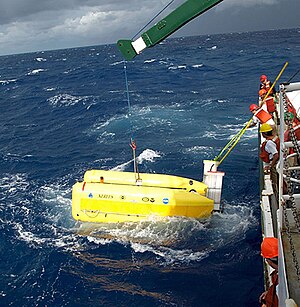Nereus (underwater vehicle)

Nereus
|
|
| History | |
|---|---|
|
|
|
| Name: | Nereus |
| Owner: | Woods Hole Oceanographic Institution (WHOI) |
| Operator: | WHOI |
| Builder: | WHOI |
| Acquired: | 1995 |
| Commissioned: | 2009 |
| In service: | 2009 |
| Homeport: | Woods Hole, Massachusetts, United States |
| Fate: | Imploded due to high pressure in Kermadec Trench |
| Status: | Lost, 10 May 2014 |
| General characteristics | |
| Type: | remotely operated underwater vehicle |
| Tonnage: | 2,800 kilograms (6,200 lb) |
| Length: | 3 metres (9.8 ft) |
| Installed power: | electrical (rechargeable Lithium-ion batteries) |
| Speed: | 3 knots |
| Test depth: | 10,902 metres (35,768 ft) |
| Complement: | unmanned |
| Sensors and processing systems: |
side-scan sonar & LED search lights |
Nereus was a hybrid unmanned autonomous underwater vehicle (HROV, a type of remotely operated underwater vehicle) built by the Woods Hole Oceanographic Institution (WHOI). Constructed as a research vehicle to operate at depths of up to 11,000 metres (36,000 ft), it was designed to explore Challenger Deep, the deepest surveyed point in the global ocean. Nereus, named for Greek sea titan Nereus (who has a man's torso and a fish-tail) through a nationwide contest of high school and college students, began its deep sea voyage to Challenger Deep in May 2009 and reached the bottom on May 31, 2009.
On this dive the Nereus reached a depth of 35,768 feet (10,902 m), making the Nereus the world's second-deepest-diving vehicle in operation at the time, and the first since 1998 to explore the Mariana Trench, the deepest part of the ocean known.
On 10 May 2014, Nereus was lost while exploring the Kermadec Trench at a depth of 9,900 metres (32,500 ft). Communications were cut off at around 2 p.m. local time, and debris retrieved later revealed that it imploded due to high pressure.
Being a hybrid ROV means that the vehicle could operate untethered or tethered with a thin optic fiber cable and operated by pilots aboard the ship. The latter enabled it to make deep dives while being highly maneuverable. The optic fiber tether has the approximate diameter of a human hair, and can bear only 4 kilograms (8.8 lb). It is made up of a thin layer of plastic surrounding a slender glass fiber core. The vehicle carried approximately 40 kilometers (25 mi) of cable wound in two small canisters that play out the fiber as the vehicle descends. This slim tether is smaller, lighter, and more cost effective than cable.
Nereus weighed approximately 3 tons in air and was about 4.25 meters (14 feet) long and 2.3 meters (8 feet) wide. Approximately 2,000 lithium-ion batteries provided its power. The vehicle made use of precisely designed ceramic spheres rather than the much heavier syntactic foam that is typically used for submersible vehicles. Each hull contained between 700 and 800 9-cm (3.5-inch) hollow spheres that were specifically designed to handle intense pressure. Nereus had a lightweight robotic manipulator arm to conduct the sample collecting that operates hydraulically and was able to perform under intense pressure.
...
Wikipedia
